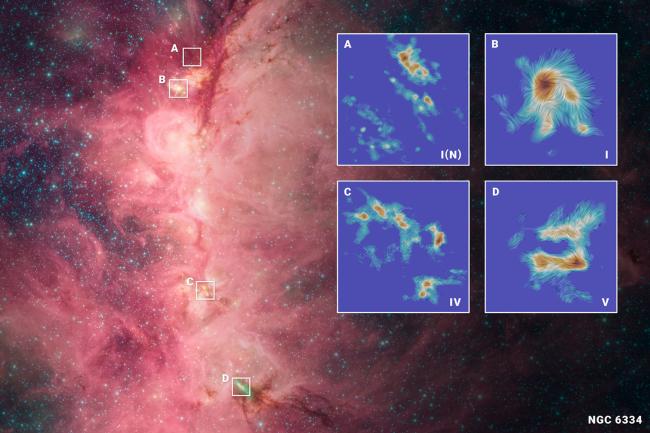Astronomers Observe Cosmic Tug-of-War as Gravity Reshapes Magnetic Fields in Star Clusters
A record-breaking ALMA survey has delivered the first evidence that collapsing gas clouds realign their magnetic fields under the powerful force of gravity

This image from NASA’s Spitzer Space Telescope shows a star formation region in molecular cloud NGC 6334, also known as the Cat's Paw Nebula. The colors correspond with emission at 3.6 microns (blue), 4.5 microns (green), and 8 microns (red). This cloud is actively forming massive stars, and is located in the constellation Scorpius, between 4,200 to 5,500 light-years from Earth. ALMA data overlaid on the image shows details of four specific areas that were observed (NGC6334I, NGC6334I(N), NGC6334IV and NGC6334V), revealing invisible forces of magnetism and gravity as they wrestle and shape the
formation of stars deep within the giant molecular cloud. The color scale in the ALMA images represents the intensity of the dust emission at a wavelength of 1.3 mm and the drapery lines represent the orientation of the magnetic field.
Credit for composite image: background, NASA/JPL-Caltech; overlay:
ESO/NAOJ/NSF NRAO; image created by NSF/AUI/NSF NRAO/M. Weiss.
Cambridge, MA (October 8, 2025)— In the largest and most detailed survey of its kind, astronomers using the Atacama Large Millimeter/submillimeter Array (ALMA) have captured the clearest picture yet of how massive stars are born. By zooming in to scales only a few times larger than our solar system, the team was able to see for the first time the ongoing tug-of-war between magnetic fields and gravity that helps stars take shape deep within giant molecular clouds. The new observations were published today in The Astrophysical Journal.
Star formation occurs when gravity squeezes cold gas until it collapses in on itself. But this epic collapse isn't driven by gravity alone, and for decades, astronomers have debated which force— magnetic fields or gravity— dominates the star formation process.
Led by Qizhou Zhang, senior astrophysicist at the Center for Astrophysics | Harvard & Smithsonian (CfA), these new observations have provided front-row seats to the tug-of-war match as seen across 17 active star-forming regions, and revealed that as gas becomes denser, gravity gains the upper hand. While magnetic fields and turbulence both start out strongly resisting the pull of gravity, magnetic fields are gradually pulled into alignment with infalling gas when gravity takes over as the leading force shaping the collapsing cloud.
"With ALMA's extraordinary sensitivity and resolution, we can now probe these cosmic birthplaces in unprecedented detail," said Zhang. "We see that gravity actually reorients the magnetic field as clouds collapse, offering new clues about how massive stars,and the clusters they inhabit, emerge from the interstellar medium."
The observations also revealed a surprising pattern: magnetic field orientations in molecular clouds don't occur randomly. Instead, they mostly occur in two ways, sometimes lining up with the direction of gravity, and sometimes perpendicular to it. The pattern is evidence of a complex and evolving relationship between these two cosmic forces.
Understanding how stars form is fundamental to almost every field of astronomy, shaping everything from the origins of the Sun to the evolution of galaxies. The research provides new clarity on the interactions between gravity and magnetic fields in massive star formation, and gives scientists powerful new tools to test and refine theories about the life cycles of stars, planets, and molecular clouds.
Resource
Zhang, Qizhou et al. (4 Oct 2025). Impact of gravity on changing magnetic field orientations in a sample of massive protostellar clusters observed with ALMA. The Astrophysical Journal. pre-print: https://iopscience.iop.org/article/10.3847/1538-4357/adfdcb
About the Center for Astrophysics | Harvard & Smithsonian
The Center for Astrophysics | Harvard & Smithsonian is a collaboration between Harvard and the Smithsonian designed to ask—and ultimately answer—humanity's greatest unresolved questions about the nature of the universe. The Center for Astrophysics is headquartered in Cambridge, MA, with research facilities across the U.S. and around the world.
About NRAO
The National Radio Astronomy Observatory (NRAO) is a facility of the U.S. National Science Foundation, operated under cooperative agreement by Associated Universities, Inc.
About ALMA
The Atacama Large Millimeter/submillimeter Array (ALMA), an international astronomy facility, is a partnership of the European Southern Observatory (ESO), the U.S. National Science Foundation (NSF) and the National Institutes of Natural Sciences (NINS) of Japan in cooperation with the Republic of Chile. ALMA is funded by ESO on behalf of its Member States, by NSF in cooperation with the National Research Council of Canada (NRC) and the National Science and Technology Council (NSTC) in Taiwan and by NINS in cooperation with the Academia Sinica (AS) in Taiwan and the Korea Astronomy and Space Science Institute (KASI).
ALMA construction and operations are led by ESO on behalf of its Member States; by the National Radio Astronomy Observatory (NRAO), managed by Associated Universities, Inc. (AUI), on behalf of North America; and by the National Astronomical Observatory of Japan (NAOJ) on behalf of East Asia. The Joint ALMA Observatory (JAO) provides the unified leadership and management of the construction, commissioning and operation of ALMA.
Media Contact:
Amy C. Oliver, FRAS
Public Affairs Officer
Center for Astrophysics | Harvard & Smithsonian
amy.oliver@cfa.harvard.edu
520-686-8712